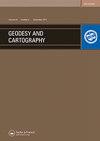重心?你想把它放在哪里?
IF 2.1
Q3 REMOTE SENSING
引用次数: 20
摘要
质心的概念在许多空间应用中都很有用,而平面多边形质心的确定是大多数地理信息系统(GIS)软件的标准功能。确定质心的一个常见原因是为多边形创建一个方便的参考点,通常用于定位文本标签。对于这样的应用,确定质心的严格性并不重要,因为在标签的定位中,例如,主要标准是它在多边形内并且合理地集中以便于解释。然而,在某些应用中,质心的确定至少会对公民的自豪感产生影响,而且很可能会对经济产生影响。我们这里指的是一个行政区域或自然区域,其中指定的质心具有一定的好奇心价值,具有成为旅游景点的潜力。这些质心通常为靠近质心的次区域提供经济利益。质心存在着各种各样的解释,本文对这些解释和计算方法进行了探讨。在澳大利亚维多利亚州的质心背景下,研究了不同解释导致的位置变化,并对GIS软件进行了评估,以确定其质心功能的有效性。本文章由计算机程序翻译,如有差异,请以英文原文为准。
The Centroid? Where would you like it to be be?
The concept of a centroid is useful for many spatial applications, and the determination of the centroid of a plane polygon is standard functionality in most Geographic Information System (GIS) software. A common reason for determining a centroid is to create a convenient point of reference for a polygon, often for positioning a textual label. For such applications, the rigour with which the centroid is determined is not critical, because in the positioning of a label, for example, the main criteria is that it be within the polygon and reasonably central for easy interpretation. However, there may be applications where the determination of a centroid has, at the very least, an impact on civic pride and quite possibly financial repercussions. We refer here to an administrative or natural region where a nominated centroid has a certain curiosity value with the potential to become a tourist attraction. Such centroids provide economic benefit to those in a sub-region, usually in close proximity to the centroid. Various interpretations of a centroid exist and this paper explores these and the methods of calculation. Variation in position resulting from different interpretations is examined in the context of the centroid of the Australian State of Victoria, and GIS software are evaluated to determine the efficacy of their centroid functions.
求助全文
通过发布文献求助,成功后即可免费获取论文全文。
去求助
来源期刊

Geodesy and Cartography
REMOTE SENSING-
CiteScore
1.50
自引率
0.00%
发文量
0
审稿时长
15 weeks
期刊介绍:
THE JOURNAL IS DESIGNED FOR PUBLISHING PAPERS CONCERNING THE FOLLOWING FIELDS OF RESEARCH: •study, establishment and improvement of the geodesy and mapping technologies, •establishing and improving the geodetic networks, •theoretical and practical principles of developing standards for geodetic measurements, •mathematical treatment of the geodetic and photogrammetric measurements, •controlling and application of the permanent GPS stations, •study and measurements of Earth’s figure and parameters of the gravity field, •study and development the geoid models,
 求助内容:
求助内容: 应助结果提醒方式:
应助结果提醒方式:


